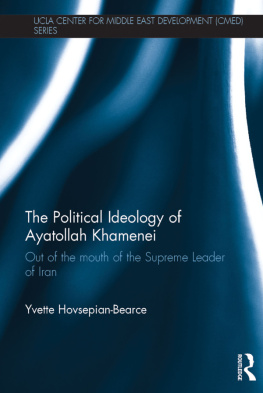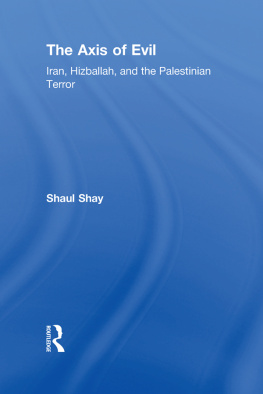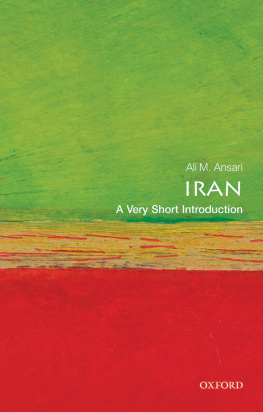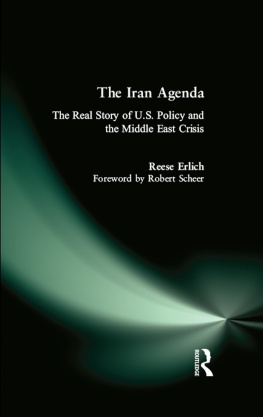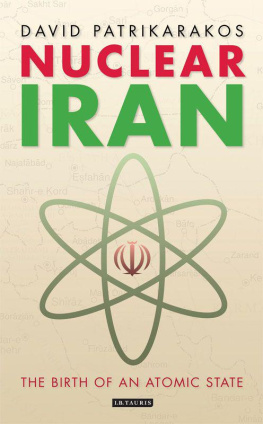ALSO BY RAY TAKEYH
The Receding Shadow of the Prophet:
The Rise and Fall of Radical Political Islam
(with Nikolas K. Gvosdev)
The Origins of the Eisenhower Doctrine:
The United States, Britain and Nassers Egypt, 19531957
HIDDEN IRAN
HIDDEN
IRAN
PARADOX AND POWER
IN THE ISLAMIC REPUBLIC
RAY TAKEYH
A COUNCIL ON FOREIGN RELATIONS BOOK

Founded in 1921, the Council on Foreign Relations is an independent, national membership organization and a nonpartisan center for scholars dedicated to producing and disseminating ideas so that individual and corporate members, as well as policymakers, journalists, students, and interested citizens in the United States and other countries, can better understand the world and the foreign policy choices facing the United States and other governments. The Council does this by convening meetings; conducting a wide-ranging Studies program; publishing Foreign Affairs, the preeminent journal covering international affairs and U.S. foreign policy; maintaining a diverse membership; sponsoring Independent Task Forces; and providing up-to-date information about the world and U.S. foreign policy on the Councils website, www.cfr.org .
THE COUNCIL TAKES NO INSTITUTIONAL POSITION ON POLICY ISSUES AND HAS NO AFFILIATION WITH THE U.S. GOVERNMENT. ALL STATEMENTS OF FACT AND EXPRESSIONS OF OPINION CONTAINED IN ITS PUBLICATIONS ARE THE SOLE RESPONSIBILITY OF THE AUTHOR OR AUTHORS.

Times Books
Henry Holt and Company, LLC
Publishers since 1866
175 Fifth Avenue
New York, New York 10010
www.henryholt.com
Henry Holt is a registered trademark of
Henry Holt and Company, LLC.
Copyright 2006 by Ray Takeyh
All rights reserved.
Distributed in Canada by H. B. Fenn and Company Ltd.
Library of Congress Cataloging-in-Publication Data
Takeyh, Ray, date.
Hidden Iran : paradox and power in the Islamic Republic / Ray Takeyh.
p. cm.
Includes bibliographical references and index.
ISBN-13: 978-0-8050-7976-0
ISBN-10: 0-8050-7976-9
1. IranPolitics and goverment19791997. 2. IranPolitics and government19973. IranForeign relations19791997. 4. IranForeign relations1997 I. Title.
DS318.825.T355 2006
327.55dc22
2006043981
Henry Holt books are available for special promotions and
premiums. For details contact: Director, Special Markets.
First Edition 2006
Designed by Kelly Too
Printed in the United States of America
1 3 5 7 9 10 8 6 4 2
To Alex:
With the hope that he will read this book one day, and be proud.
HIDDEN IRAN
INTRODUCTION:
GETTING IRAN WRONG
I n his State of the Union address on January 31, 2006, President George W. Bush turned his attention to Iran, describing it as a nation now held hostage by a small clerical elite that is isolating and repressing its people. The president went on to stress that the Iranian government is defying the world with its nuclear ambitions, and the nations of the world must not permit the Iranian regime to gain nuclear weapons.the original 1979 revolution that launched the Islamic Republic to the more recent confrontation over Irans nuclear intentions, the United States has persistently misjudged Irans clerical oligarchs.
Contrary to President Bushs assertions, and his previous depiction of Iran as a member of an axis of evil, an unsavory state on a par with the totalitarian regimes of Saddam Hussein in Iraq and Kim Jong Il in North Korea, Iran differs dramatically from its Arab neighbors, much less the hermetic North Korean regime. Irans institutions, elections, and political factions matter and wield considerable impact over the governments course of action. Debates rage within the parliament and the presidential office, in the seminaries and on the street, among the media and in the halls of academia. Far from being a stagnant authoritarian state, Irans elaborate and Orwellian bureaucracy, its fiercely competitive political culture, and its singular personalities perennially jockey for influence and power. It is the interplay of all these institutions and actors that ultimately determines Irans policies.
After more than a quarter-century in power, the Islamic Republic is at a crossroads as a new generation of stern conservatives has assumed power with a determination to return to the roots of the revolution. However, the conflict gripping Iran stems not from a straightforward resurgence of reactionary politics, but from a contradiction deeply embedded in its governing structure. From its inception, the Islamic Republic was a state divided between competing centers of power and profoundly differing conceptions of political authority. The original constitution pledged that the foremost purpose of the state was to create conditions under which may be nurtured the noble and universal values of Islam.overthrow of the monarchy. Since then, disagreements and tensions have persisted between those seeking to establish a divine order and those advocating a more representative polity. Despite its absolutist pretensions, the clerical estate has never managed to exercise undisputed dominance over public affairs. Throughout its tenure, popular will, however circumscribed by theological fiat, remained an important arbiter of the Iranian states legitimacy and thus its very survival.
Iran today is a nation in search of an identity, a state that oscillates between promises of democratic modernity and retrogressive tradition. Despite all the sensational setbacks of Muhammad Khatamis reform movement, the one enduring legacy of its electoral triumphs in 1997 and 2001 has been to make it impossible for Iran to become a rigid authoritarian state. The call for representation and the rule of law, for accountability and equality, have transformed the average Iranian from a passive observer of clerical politics into an active agent of change. The resilience of the forces of progress stems from their diversity. Clerical reformers, disillusioned youth, a burdened middle class, women seeking emancipation, and intellectuals yearning for freedom of thought have come together in their demand for a government responsive to its citizenry. Despite the apparent consolidation of conservative power and the election to the presidency in 2005 of an unreconstructed ideologue, Iran will change. In the long run, Irans sophisticated and youthful populace can be neither appeased by cosmetic concessions nor silenced by threats of coercion.
However, Irans democratic transition must come on its own terms, and at its own pace. An American president castigating Iran as part of an axis of evil, or denigrating its political process by proclaiming its elections a fraud even before they take place, only provides ammunition to hard-liners decrying Irans democrats as unwitting agents of Western machinations. Contrary to Washingtons depictions, the struggle in Iran is not a simple conflict between the people and the mullahs. Irans factional politics, ideological divisions, and political rivalries are much more complex and nuanced. The dissident clerics within the seminaries, the young functionaries waging a turf war in the government, the student organizations defying the authorities, and the women who persistently challenge the prevailing religious strictures are all part of the same movement seeking to liberalize the parameters of the state. The stark distinction between the people and the regime quickly fades when one considers how decentralized and flexible Irans Islamic order has become in the intervening three decades. Before stepping into the convoluted fray of Iranian politics, Washington would be wise to have a better appreciation of Irans complexities and contradictions.
Next page

